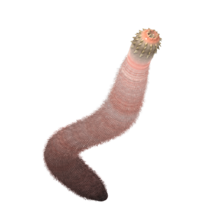| Ancalagon minor Temporal range:
| |
|---|---|

| |
| Reconstruction of Ancalagon minor | |
| Scientific classification | |
| Domain: | Eukaryota |
| Kingdom: | Animalia |
| Stem group: | Priapulida (?) |
| Class: | †Archaeopriapulida |
| Family: | †Ancalagonidae Conway Morris, 1977[1] |
| Genus: | †Ancalagon Conway Morris, 1977[1] |
| Species | |
| |
| Synonyms | |
| |
Ancalagon minor is an extinct priapulid worm known from the Cambrian Burgess Shale.[3]
Because it superficially resembles the modern-day internal parasites known as the acanthocephalids or "spiny-headed worms," A. minor was once thought to be, or once thought to resemble the hypothetical free-living ancestor of acanthocephalids.[3][4] Two specimens of Ancalagon are known from the Greater Phyllopod bed, where they comprise < 0.01% of the community.[5]
Along with the other Cambrian worms such as Ottoia, Selkirkia, Louisella, Fieldia, Scolecofurca, and Lecythioscopa, the organism may fall into a clade termed "Archaeopriapulida," a stem group to the Priapulids proper.[6] However, the morphological similarity of these organisms to their modern cousins is remarkable, especially for the Burgess Shale.[7] A phylogenetic analysis does not provide a great deal of resolution to the relationships between these basal worms.[8]
- ^ a b Conway Morris, S. "Fossil priapulid worms". Special Papers in Palaeontology. 20.
- ^ Haaramo, Mikko (2003). "Scalidophora – †palaeoscolecids, priapulids, mud dragons and brush heads". Mikko's Phylogeny Archive. Archived from the original on 2023-04-22.
- ^ a b Conway Morris, S. (1979). "The Burgess Shale (Middle Cambrian) Fauna". Annual Review of Ecology and Systematics. 10: 327–349. doi:10.1146/annurev.es.10.110179.001551.
- ^ Conway Morris, S.; Crompton, D. W. T. (1982). "The Origins and Evolution of the Acanthocephala". Biological Reviews. 57: 85–115. doi:10.1111/j.1469-185X.1982.tb00365.x. S2CID 84098740.
- ^ Caron, Jean-Bernard; Jackson, Donald A. (October 2006). "Taphonomy of the Greater Phyllopod Bed community, Burgess Shale". PALAIOS. 21 (5): 451–65. Bibcode:2006Palai..21..451C. doi:10.2110/palo.2003.P05-070R. JSTOR 20173022. S2CID 53646959.
- ^ Por, F. D. (1983). "Class Seticoronaria and Phylogeny of the Phylum Priapulida". Zoologica Scripta. 12 (4): 267–272. doi:10.1111/j.1463-6409.1983.tb00510.x. S2CID 85091685.
- ^ Huang, D. Y.; Vannier, J.; Chen, J.Y. (2004). "Anatomy and lifestyles of Early Cambrian priapulid worms exemplified by Corynetis and Anningvermis from the Maotianshan Shale (SW China)". Lethaia. 37: 21–33. doi:10.1080/00241160410005088.
- ^ Wills, M. A. (1 April 1998). "Cambrian and Recent Disparity: the Picture from Priapulids". Paleobiology. 24 (2): 177–199. doi:10.1666/0094-8373(1998)024[0177:CARDTP]2.3.CO;2. JSTOR 2401237. S2CID 88647544.